

Compact Muon Solenoid
LHC, CERN
| CMS-PAS-HIG-17-012 | ||
| Search for a new scalar resonance decaying to a pair of Z bosons in proton-proton collisions at $\sqrt {s} = $ 13 TeV | ||
| CMS Collaboration | ||
| December 2017 | ||
| Abstract: A search for a new scalar resonance decaying to a pair of Z bosons is performed in the mass range from 130 GeV to 3 TeV and for various width scenarios. The analysis is based on proton-proton collisions recorded by the CMS experiment at the CERN LHC in 2016, corresponding to an integrated luminosity of 35.9 fb$^{-1}$ at a center-of-mass energy of 13 TeV. Z boson pair decays are reconstructed using the $ 4 \ell $, $ 2 \ell 2 \mathrm{q} $, and $ 2 \ell 2 \nu $ final states, where $\ell = \mathrm{e}$ or $\mu$. Both gluon fusion and electroweak production of the scalar resonance are considered, with a free parameter describing their relative cross sections. A dedicated categorization of events, based on the kinematic properties of associated jets, and matrix-element techniques are employed for an optimal signal-to-background separation. Description of the interference between signal and background amplitudes for a resonance of an arbitrary width is included. No significant excess of events is observed and limits are set on the production cross section for a new scalar boson for a large range of masses and widths. | ||
|
Links:
CDS record (PDF) ;
inSPIRE record ;
CADI line (restricted) ;
These preliminary results are superseded in this paper, JHEP 06 (2018) 127. The superseded preliminary plots can be found here. |
||
| Figures | |

png pdf |
Figure 1:
Illustration of an X boson production from ggH, $\mathrm{g} \mathrm{g} \to {\mathrm {X}} \to \mathrm{Z} \mathrm{Z} \to (\ell ^+\ell ^-)(f\bar{f})$ (left) and VBF $\mathrm{q} {\mathrm{q} ^\prime}\to \mathrm{q} {\mathrm{q} ^\prime} {\mathrm {X}} \to \mathrm{q} {\mathrm{q} ^\prime}\mathrm{Z} \mathrm{Z} $ (right). |

png pdf |
Figure 1-a:
Illustration of an X boson production from ggH, $\mathrm{g} \mathrm{g} \to {\mathrm {X}} \to \mathrm{Z} \mathrm{Z} \to (\ell ^+\ell ^-)(f\bar{f})$. |
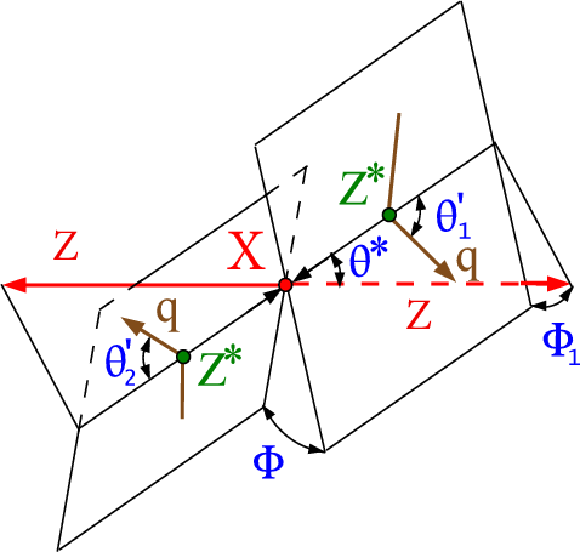
png pdf |
Figure 1-b:
Illustration of an X boson production from VBF $\mathrm{q} {\mathrm{q} ^\prime}\to \mathrm{q} {\mathrm{q} ^\prime} {\mathrm {X}} \to \mathrm{q} {\mathrm{q} ^\prime}\mathrm{Z} \mathrm{Z} $. |

png pdf |
Figure 2:
Distribution of the four-leptons invariant mass in untagged (upper left), VBF-tagged (upper right) and RSE (bottom left) category and of ${\cal D}_{\rm bkg}^{\rm kin}$ for all selected events (bottom right). Signal expectations including the interference effect for several mass and width hypotheses are shown. The cross section for the signal corresponds to the expected exclusion value (times a scaling indicated on the panel to make them more visible), and is normalized to a total of 400 events in the bottom right panel. |
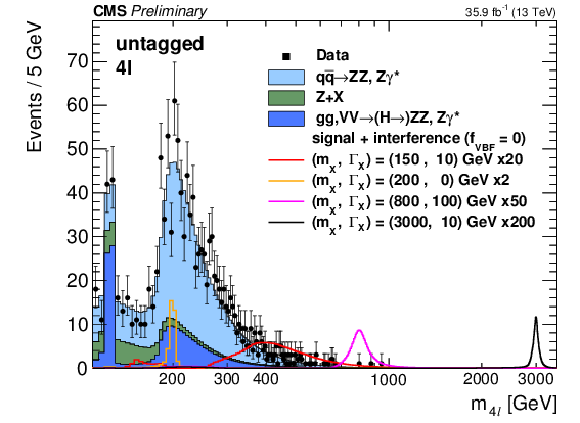
png pdf |
Figure 2-a:
Distribution of the four-leptons invariant mass in the untagged category. Signal expectations including the interference effect for several mass and width hypotheses are shown. The cross section for the signal corresponds to the expected exclusion value (times a scaling indicated on the panel to make them more visible). |
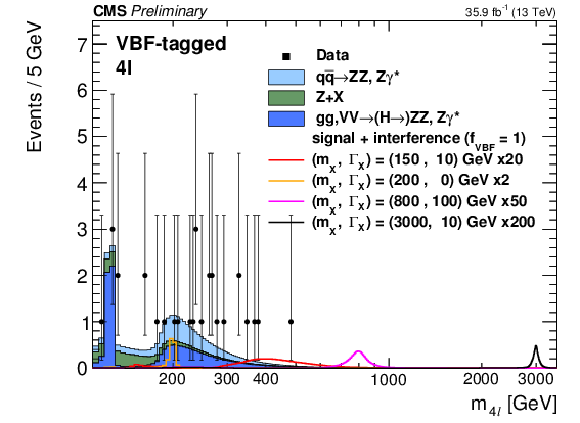
png pdf |
Figure 2-b:
Distribution of the four-leptons invariant mass in the VBF-tagged category. Signal expectations including the interference effect for several mass and width hypotheses are shown. The cross section for the signal corresponds to the expected exclusion value (times a scaling indicated on the panel to make them more visible). |
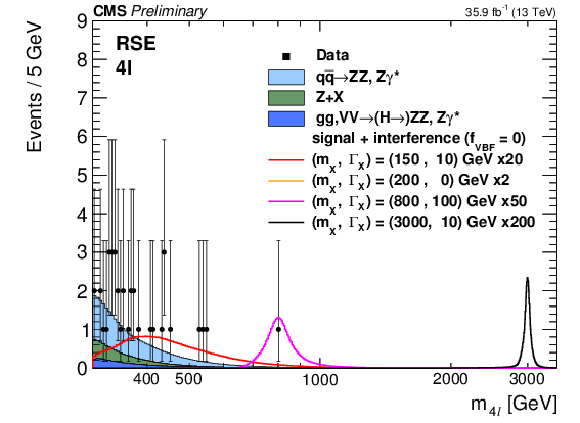
png pdf |
Figure 2-c:
Distribution of the four-leptons invariant mass in the RSE category. Signal expectations including the interference effect for several mass and width hypotheses are shown. The cross section for the signal corresponds to the expected exclusion value (times a scaling indicated on the panel to make them more visible). |
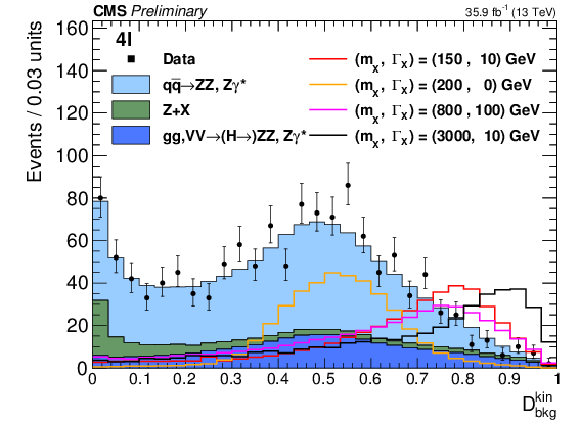
png pdf |
Figure 2-d:
Distribution of ${\cal D}_{\rm bkg}^{\rm kin}$ for all selected events. Signal expectations including the interference effect for several mass and width hypotheses are shown. The cross section for the signal is normalized to a total of 400 events. |
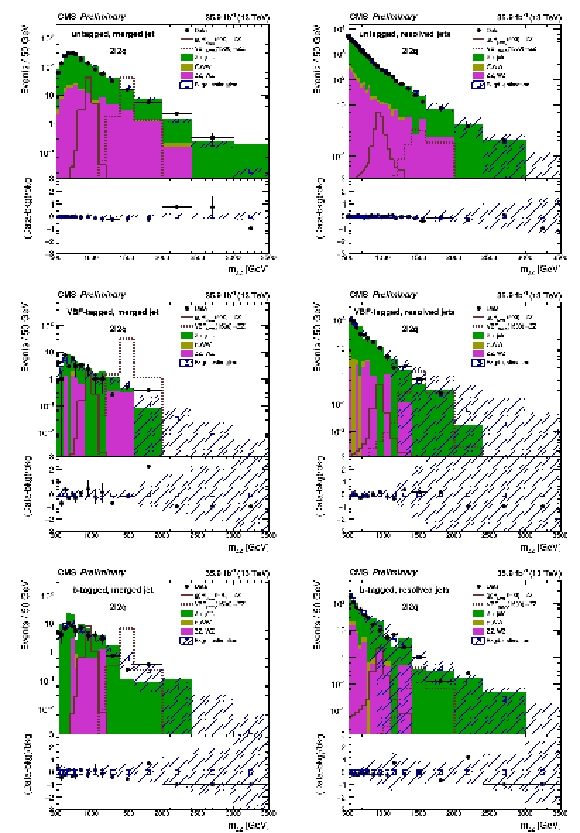
png pdf |
Figure 3:
Distribution of the invariant mass $ {m_{{\mathrm{Z}} {\mathrm{Z}}}} $ in the signal region for the merged (left) and resolved (right) case for the different categories in the $ 2 \ell 2 \mathrm{q} $ channel. The points represent the data, the stacked histograms the expected background from simulation, and the open histograms the expected signal. The blue hatched bands refer to the sum of MC- and data-derived background estimations as described in the text. Lower panels show the relative difference between data and background estimation in each case. |
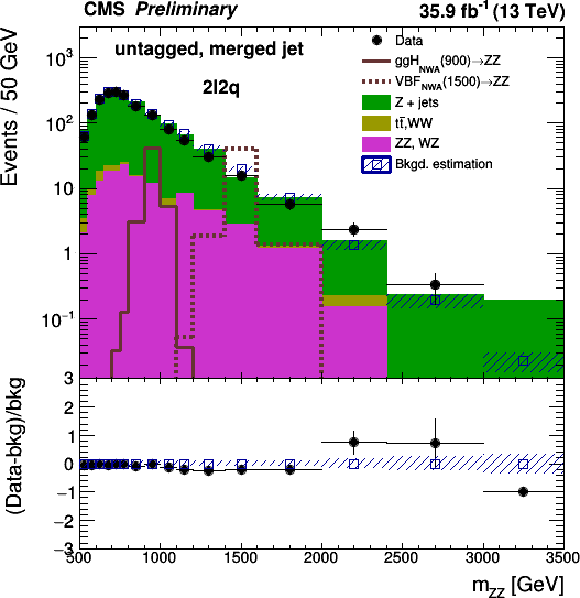
png |
Figure 3-a:
Distribution of the invariant mass $ {m_{{\mathrm{Z}} {\mathrm{Z}}}} $ in the signal region for the merged case for the untagged category in the $ 2 \ell 2 \mathrm{q} $ channel. The points represent the data, the stacked histograms the expected background from simulation, and the open histograms the expected signal. The blue hatched bands refer to the sum of MC- and data-derived background estimations as described in the text. The lower panel shows the relative difference between data and background estimation in each case. |

png |
Figure 3-b:
Distribution of the invariant mass $ {m_{{\mathrm{Z}} {\mathrm{Z}}}} $ in the signal region for the resolved case for the untagged category in the $ 2 \ell 2 \mathrm{q} $ channel. The points represent the data, the stacked histograms the expected background from simulation, and the open histograms the expected signal. The blue hatched bands refer to the sum of MC- and data-derived background estimations as described in the text. The lower panel shows the relative difference between data and background estimation in each case. |

png |
Figure 3-c:
Distribution of the invariant mass $ {m_{{\mathrm{Z}} {\mathrm{Z}}}} $ in the signal region for the merged case for the VBF-tagged category in the $ 2 \ell 2 \mathrm{q} $ channel. The points represent the data, the stacked histograms the expected background from simulation, and the open histograms the expected signal. The blue hatched bands refer to the sum of MC- and data-derived background estimations as described in the text. The lower panel shows the relative difference between data and background estimation in each case. |
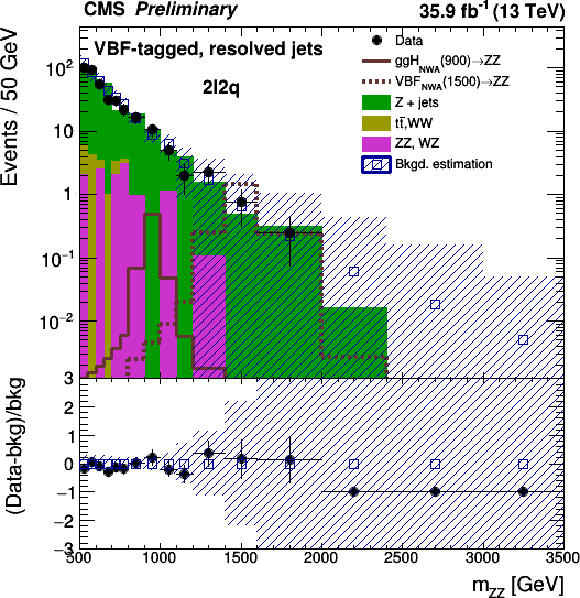
png |
Figure 3-d:
Distribution of the invariant mass $ {m_{{\mathrm{Z}} {\mathrm{Z}}}} $ in the signal region for the resolved case for the VBF-tagged category in the $ 2 \ell 2 \mathrm{q} $ channel. The points represent the data, the stacked histograms the expected background from simulation, and the open histograms the expected signal. The blue hatched bands refer to the sum of MC- and data-derived background estimations as described in the text. The lower panel shows the relative difference between data and background estimation in each case. |
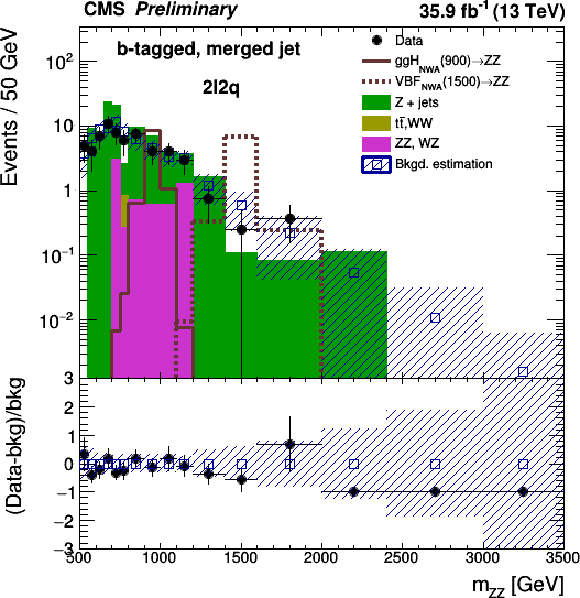
png |
Figure 3-e:
Distribution of the invariant mass $ {m_{{\mathrm{Z}} {\mathrm{Z}}}} $ in the signal region for the merged case for the b-tagged category in the $ 2 \ell 2 \mathrm{q} $ channel. The points represent the data, the stacked histograms the expected background from simulation, and the open histograms the expected signal. The blue hatched bands refer to the sum of MC- and data-derived background estimations as described in the text. The lower panel shows the relative difference between data and background estimation in each case. |
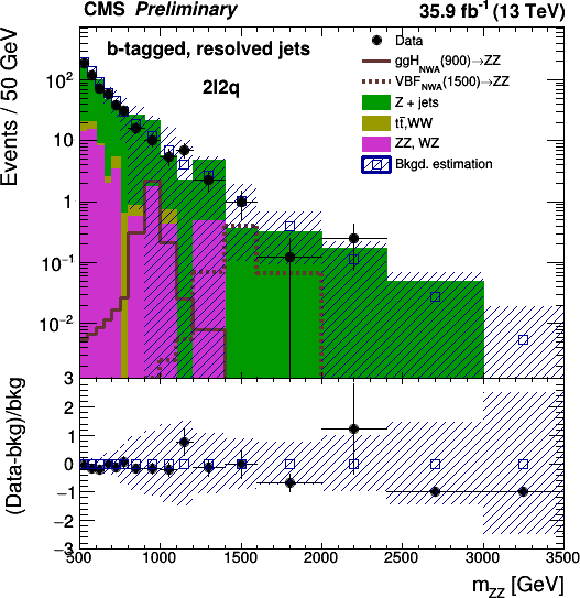
png |
Figure 3-f:
Distribution of the invariant mass $ {m_{{\mathrm{Z}} {\mathrm{Z}}}} $ in the signal region for the resolved case for the b-tagged category in the $ 2 \ell 2 \mathrm{q} $ channel. The points represent the data, the stacked histograms the expected background from simulation, and the open histograms the expected signal. The blue hatched bands refer to the sum of MC- and data-derived background estimations as described in the text. The lower panel shows the relative difference between data and background estimation in each case. |
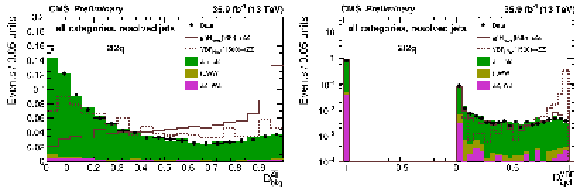
png pdf |
Figure 4:
Distribution of the discriminant ${\mathcal {D}_\textrm {bkg}^\textrm {Zjj}} $ (left) and $ {\mathcal {D}_\textrm {2jet}^\textrm {VBF}} $ (right) in the signal region for the resolved selection. The points represent the data, the stacked histograms the expected background from simulation, and the open histograms the expected signal. |

png pdf |
Figure 4-a:
Distribution of the discriminant ${\mathcal {D}_\textrm {bkg}^\textrm {Zjj}} $ in the signal region for the resolved selection. The points represent the data, the stacked histograms the expected background from simulation, and the open histograms the expected signal. |
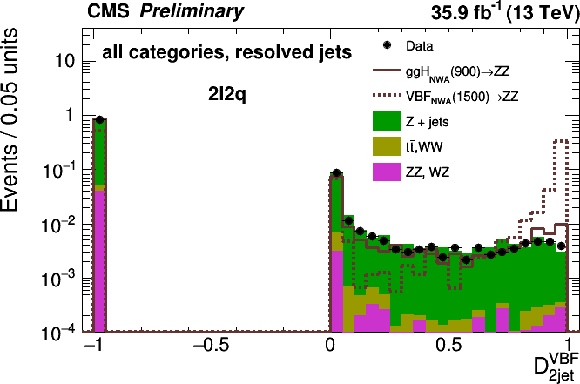
png pdf |
Figure 4-b:
Distribution of $ {\mathcal {D}_\textrm {2jet}^\textrm {VBF}} $ in the signal region for the resolved selection. The points represent the data, the stacked histograms the expected background from simulation, and the open histograms the expected signal. |
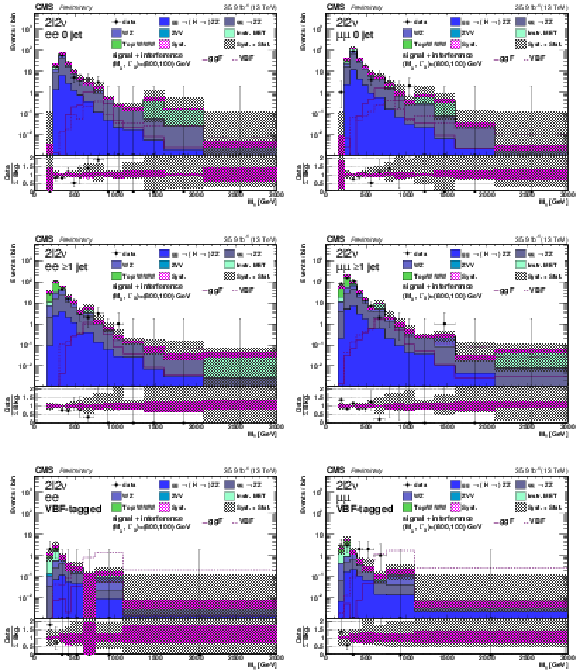
png pdf |
Figure 5:
Distribution of the transverse mass $m_{\mathrm{T}}$ in the signal region for the different analysis categories for the $ 2 \ell 2 \nu $ channel, in the ee (left) and $\mu \mu $ final states (right). The points represent the data and the stacked histograms the expected background. The open histograms show the expected gluon-fusion and VBF signals for cross sections times branching fraction $\sigma (\rm p\rm p \to \rm H \to {\mathrm{Z}} {\mathrm{Z}})=$ 50 fb. Lower panels show the ratio of data to the expected background. The shaded areas show the systematic and total statistical plus systematic uncertainties in the background estimation. |

png pdf |
Figure 5-a:
Distribution of the transverse mass $m_{\mathrm{T}}$ in the signal region for the 0-jet category for the $ 2 \ell 2 \nu $ channel, in the ee final state. The points represent the data and the stacked histograms the expected background. The open histograms show the expected gluon-fusion and VBF signals for cross sections times branching fraction $\sigma (\rm p\rm p \to \rm H \to {\mathrm{Z}} {\mathrm{Z}})=$ 50 fb. Lower panels show the ratio of data to the expected background. The shaded areas show the systematic and total statistical plus systematic uncertainties in the background estimation. |

png pdf |
Figure 5-b:
Distribution of the transverse mass $m_{\mathrm{T}}$ in the signal region for the 0-jet category for the $ 2 \ell 2 \nu $ channel, in the $\mu \mu $ final state. The points represent the data and the stacked histograms the expected background. The open histograms show the expected gluon-fusion and VBF signals for cross sections times branching fraction $\sigma (\rm p\rm p \to \rm H \to {\mathrm{Z}} {\mathrm{Z}})=$ 50 fb. Lower panels show the ratio of data to the expected background. The shaded areas show the systematic and total statistical plus systematic uncertainties in the background estimation. |

png pdf |
Figure 5-c:
Distribution of the transverse mass $m_{\mathrm{T}}$ in the signal region for the $\geq$ 1-jet category for the $ 2 \ell 2 \nu $ channel, in the ee final state. The points represent the data and the stacked histograms the expected background. The open histograms show the expected gluon-fusion and VBF signals for cross sections times branching fraction $\sigma (\rm p\rm p \to \rm H \to {\mathrm{Z}} {\mathrm{Z}})=$ 50 fb. Lower panels show the ratio of data to the expected background. The shaded areas show the systematic and total statistical plus systematic uncertainties in the background estimation. |

png pdf |
Figure 5-d:
Distribution of the transverse mass $m_{\mathrm{T}}$ in the signal region for the $\geq$ 1-jet category for the $ 2 \ell 2 \nu $ channel, in the $\mu \mu $ final state. The points represent the data and the stacked histograms the expected background. The open histograms show the expected gluon-fusion and VBF signals for cross sections times branching fraction $\sigma (\rm p\rm p \to \rm H \to {\mathrm{Z}} {\mathrm{Z}})=$ 50 fb. Lower panels show the ratio of data to the expected background. The shaded areas show the systematic and total statistical plus systematic uncertainties in the background estimation. |
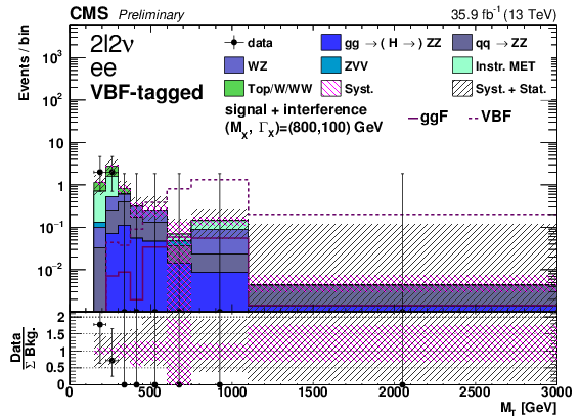
png pdf |
Figure 5-e:
Distribution of the transverse mass $m_{\mathrm{T}}$ in the signal region for the VBF-tagged category for the $ 2 \ell 2 \nu $ channel, in the ee final state. The points represent the data and the stacked histograms the expected background. The open histograms show the expected gluon-fusion and VBF signals for cross sections times branching fraction $\sigma (\rm p\rm p \to \rm H \to {\mathrm{Z}} {\mathrm{Z}})=$ 50 fb. Lower panels show the ratio of data to the expected background. The shaded areas show the systematic and total statistical plus systematic uncertainties in the background estimation. |
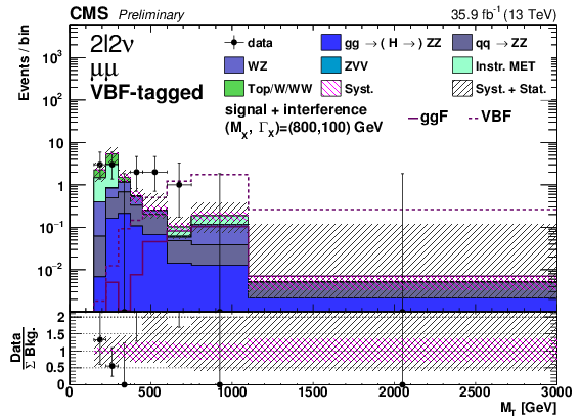
png pdf |
Figure 5-f:
Distribution of the transverse mass $m_{\mathrm{T}}$ in the signal region for the VBF-tagged category for the $ 2 \ell 2 \nu $ channel, in the $\mu \mu $ final state. The points represent the data and the stacked histograms the expected background. The open histograms show the expected gluon-fusion and VBF signals for cross sections times branching fraction $\sigma (\rm p\rm p \to \rm H \to {\mathrm{Z}} {\mathrm{Z}})=$ 50 fb. Lower panels show the ratio of data to the expected background. The shaded areas show the systematic and total statistical plus systematic uncertainties in the background estimation. |

png pdf |
Figure 6:
The efficiency times acceptance for signal events to pass the $X\rightarrow {\mathrm{Z}} {\mathrm{Z}} \rightarrow 4\ell $ (top) and $X\rightarrow {\mathrm{Z}} {\mathrm{Z}} \rightarrow 2\ell 2\mathrm{q} $ (bottom) selection as a function of the generated mass $m_{{\mathrm{Z}} {\mathrm{Z}}}^{\rm Gen}$, from ggH (left) and VBF (right) production modes. |
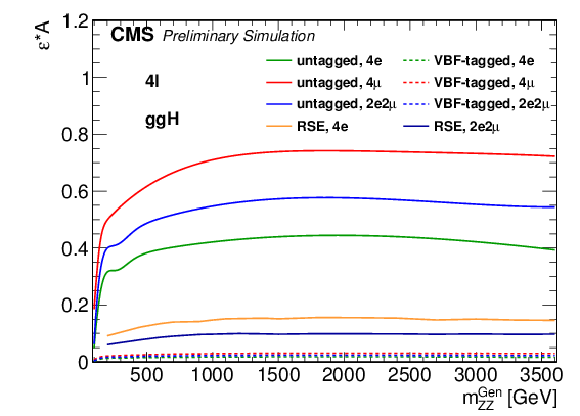
png pdf |
Figure 6-a:
The efficiency times acceptance for signal events to pass the $X\rightarrow {\mathrm{Z}} {\mathrm{Z}} \rightarrow 4\ell $ selection as a function of the generated mass $m_{{\mathrm{Z}} {\mathrm{Z}}}^{\rm Gen}$, from the ggH production mode. |

png pdf |
Figure 6-b:
The efficiency times acceptance for signal events to pass the $X\rightarrow {\mathrm{Z}} {\mathrm{Z}} \rightarrow 4\ell $ selection as a function of the generated mass $m_{{\mathrm{Z}} {\mathrm{Z}}}^{\rm Gen}$, from the VBF production mode. |

png pdf |
Figure 6-c:
The efficiency times acceptance for signal events to pass the $X\rightarrow {\mathrm{Z}} {\mathrm{Z}} \rightarrow 2\ell 2\mathrm{q} $ selection as a function of the generated mass $m_{{\mathrm{Z}} {\mathrm{Z}}}^{\rm Gen}$, from the ggH production mode. |
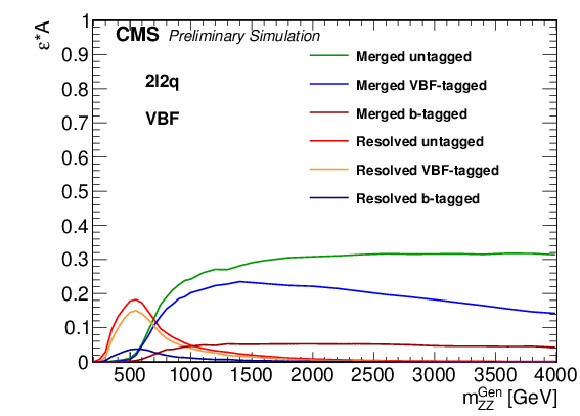
png pdf |
Figure 6-d:
The efficiency times acceptance for signal events to pass the $X\rightarrow {\mathrm{Z}} {\mathrm{Z}} \rightarrow 2\ell 2\mathrm{q} $ selection as a function of the generated mass $m_{{\mathrm{Z}} {\mathrm{Z}}}^{\rm Gen}$, from the VBF production mode. |

png pdf |
Figure 7:
Parameterization of the four-leptons invariant mass for ggH (left) and VBF (right) production mode, for $m_{H} =$ 450 GeV, $\Gamma _{H} = $ 10 GeV. The interference contributions from H(125) and gg $\to $ ZZ or VV $\rightarrow {\mathrm{Z}} {\mathrm{Z}} $ background are also shown. The signal cross section used corresponds to the limit obtained in the $4\ell $ final state. |

png pdf |
Figure 7-a:
Parameterization of the four-leptons invariant mass for the ggH production mode, for $m_{H} =$ 450 GeV, $\Gamma _{H} = $ 10 GeV. The interference contributions from H(125) and gg $\to $ ZZ or VV $\rightarrow {\mathrm{Z}} {\mathrm{Z}} $ background are also shown. The signal cross section used corresponds to the limit obtained in the $4\ell $ final state. |

png pdf |
Figure 7-b:
Parameterization of the four-leptons invariant mass for the VBF production mode, for $m_{H} =$ 450 GeV, $\Gamma _{H} = $ 10 GeV. The interference contributions from H(125) and gg $\to $ ZZ or VV $\rightarrow {\mathrm{Z}} {\mathrm{Z}} $ background are also shown. The signal cross section used corresponds to the limit obtained in the $4\ell $ final state. |
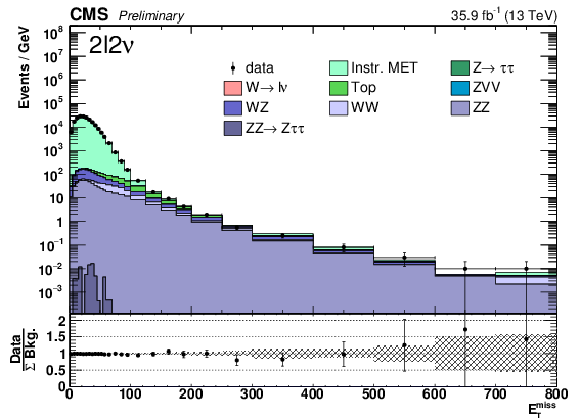
png pdf |
Figure 8:
Distribution of the missing transverse energy ${E_{\mathrm {T}}^{\text {miss}}}$ in the dilepton signal region. Points represent the data, stacked histograms the expected backgrounds and open histograms the expected signals. |
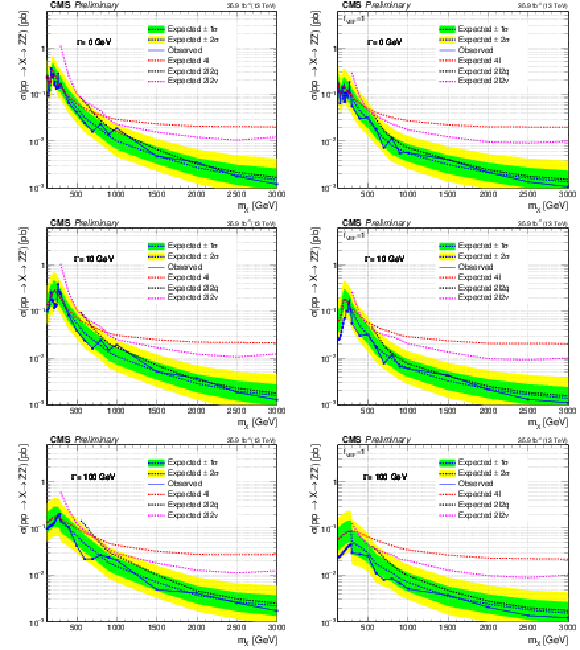
png pdf |
Figure 9:
Expected and observed upper limits at the 95% CL on the pp$\to {\mathrm {X}} \to {\mathrm{Z}} {\mathrm{Z}} $ cross section as a function of $m_ {\mathrm {X}} $ and for several $\Gamma _ {\mathrm {X}} $ values with $f_{\rm VBF}$ being a free parameter (left) and fixed to 1 (right) with 35.9 fb$^{-1}$ of data at 13 TeV. The results are shown for $4\ell $, $2\ell 2\mathrm{q} $ and $2\ell 2\nu $ channels and combined. |
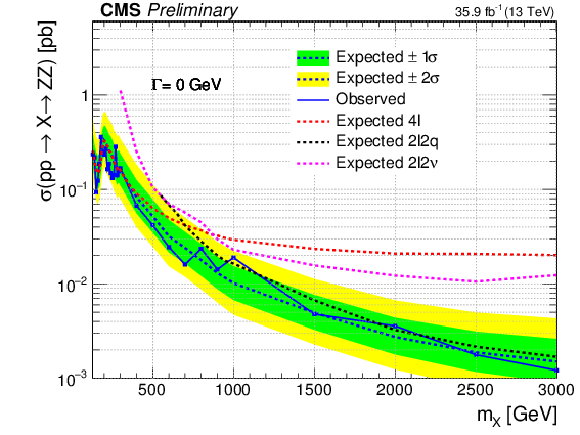
png pdf |
Figure 9-a:
Expected and observed upper limits at the 95% CL on the pp$\to {\mathrm {X}} \to {\mathrm{Z}} {\mathrm{Z}} $ cross section as a function of $m_ {\mathrm {X}} $ and for $\Gamma _ {\mathrm {X}} = $ 0 GeV with $f_{\rm VBF}$ being a free parameter with 35.9 fb$^{-1}$ of data at 13 TeV. The results are shown for $4\ell $, $2\ell 2\mathrm{q} $ and $2\ell 2\nu $ channels and combined. |
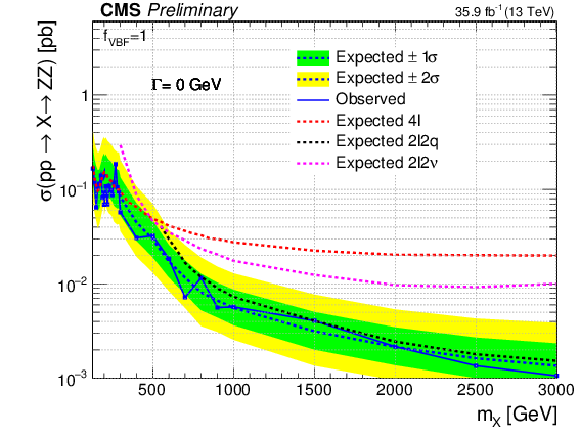
png pdf |
Figure 9-b:
Expected and observed upper limits at the 95% CL on the pp$\to {\mathrm {X}} \to {\mathrm{Z}} {\mathrm{Z}} $ cross section as a function of $m_ {\mathrm {X}} $ and for $\Gamma _ {\mathrm {X}} = $ 0 GeV with $f_{\rm VBF}$ fixed to 1 with 35.9 fb$^{-1}$ of data at 13 TeV. The results are shown for $4\ell $, $2\ell 2\mathrm{q} $ and $2\ell 2\nu $ channels and combined. |
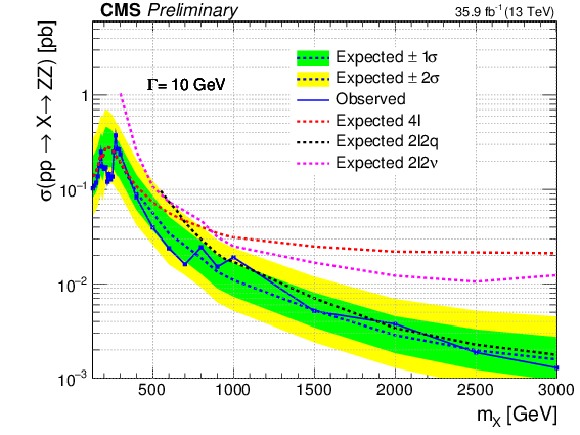
png pdf |
Figure 9-c:
Expected and observed upper limits at the 95% CL on the pp$\to {\mathrm {X}} \to {\mathrm{Z}} {\mathrm{Z}} $ cross section as a function of $m_ {\mathrm {X}} $ and for $\Gamma _ {\mathrm {X}} = $ 10 GeV with $f_{\rm VBF}$ being a free parameter with 35.9 fb$^{-1}$ of data at 13 TeV. The results are shown for $4\ell $, $2\ell 2\mathrm{q} $ and $2\ell 2\nu $ channels and combined. |

png pdf |
Figure 9-d:
Expected and observed upper limits at the 95% CL on the pp$\to {\mathrm {X}} \to {\mathrm{Z}} {\mathrm{Z}} $ cross section as a function of $m_ {\mathrm {X}} $ and for $\Gamma _ {\mathrm {X}} = $ 10 GeV with $f_{\rm VBF}$ fixed to 1 with 35.9 fb$^{-1}$ of data at 13 TeV. The results are shown for $4\ell $, $2\ell 2\mathrm{q} $ and $2\ell 2\nu $ channels and combined. |

png pdf |
Figure 9-e:
Expected and observed upper limits at the 95% CL on the pp$\to {\mathrm {X}} \to {\mathrm{Z}} {\mathrm{Z}} $ cross section as a function of $m_ {\mathrm {X}} $ and for $\Gamma _ {\mathrm {X}} = $ 100 GeV with $f_{\rm VBF}$ being a free parameter with 35.9 fb$^{-1}$ of data at 13 TeV. The results are shown for $4\ell $, $2\ell 2\mathrm{q} $ and $2\ell 2\nu $ channels and combined. |

png pdf |
Figure 9-f:
Expected and observed upper limits at the 95% CL on the pp$\to {\mathrm {X}} \to {\mathrm{Z}} {\mathrm{Z}} $ cross section as a function of $m_ {\mathrm {X}} $ and for $\Gamma _ {\mathrm {X}} = $ 100 GeV with $f_{\rm VBF}$ fixed to 1 with 35.9 fb$^{-1}$ of data at 13 TeV. The results are shown for $4\ell $, $2\ell 2\mathrm{q} $ and $2\ell 2\nu $ channels and combined. |
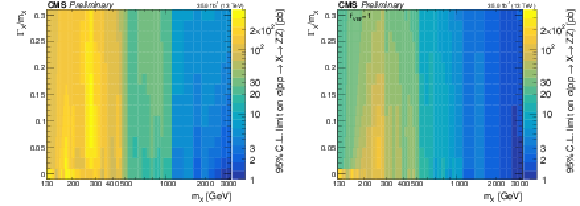
png pdf |
Figure 10:
Observed upper limits at the 95% CL on the pp$\to {\mathrm {X}} \to {\mathrm{Z}} {\mathrm{Z}} $ cross section as a function of $m_ {\mathrm {X}} $ and $\Gamma _ {\mathrm {X}} /m_ {\mathrm {X}} $ values with $f_{\rm VBF}$ being a free parameter (left) and fixed to 1 (right) with 35.9 fb$^{-1}$ of data at 13 TeV. The results are shown for the $4\ell $, $2\ell 2\mathrm{q} $ and $2\ell 2\nu $ channels combined. |

png pdf |
Figure 10-a:
Observed upper limits at the 95% CL on the pp$\to {\mathrm {X}} \to {\mathrm{Z}} {\mathrm{Z}} $ cross section as a function of $m_ {\mathrm {X}} $ and $\Gamma _ {\mathrm {X}} /m_ {\mathrm {X}} $ values with $f_{\rm VBF}$ being a free parameter with 35.9 fb$^{-1}$ of data at 13 TeV. The results are shown for the $4\ell $, $2\ell 2\mathrm{q} $ and $2\ell 2\nu $ channels combined. |

png pdf |
Figure 10-b:
Observed upper limits at the 95% CL on the pp$\to {\mathrm {X}} \to {\mathrm{Z}} {\mathrm{Z}} $ cross section as a function of $m_ {\mathrm {X}} $ and $\Gamma _ {\mathrm {X}} /m_ {\mathrm {X}} $ values with $f_{\rm VBF}$ fixed to 1 with 35.9 fb$^{-1}$ of data at 13 TeV. The results are shown for the $4\ell $, $2\ell 2\mathrm{q} $ and $2\ell 2\nu $ channels combined. |
| Tables | |

png pdf |
Table 1:
Sources of uncertainties considered in each of the channels included in this analysis. Uncertainties are given in percent. The numbers shown in ranges represent the uncertainties in different final states, categories. Most uncertainties affect the normalization of the data or simulated yields, those that affect the shape of kinematic distributions as well are labeled with (*). |
| Summary |
| A search for a new scalar resonance decaying to a pair of Z bosons is performed for a range of masses between 130 GeV and 3 TeV with the full data set recorded by the CMS experiment at 13 TeV during 2016 and corresponding to an integrated luminosity of 35.9 fb$^{-1}$. Three final states $\mathrm{Z}\mathrm{Z}\to 4\ell$, $2\ell2\mathrm{q}$, and $2\ell2\nu$ are used and combined in the analysis. Both gluon fusion and electroweak production of the scalar resonance are considered with a free parameter describing their relative cross sections. A dedicated categorization of events based on the kinematic properties of the associated jets is used to improve the sensitivity of the search. No significant excess of events is observed and limits are set on the production cross section for a wide range of masses and widths, and for different production mechanisms. |
| References | ||||
| 1 | S. L. Glashow | Partial-symmetries of Weak Interactions | NP 22 (1961) 579 | |
| 2 | F. Englert and R. Brout | Broken Symmetry and the Mass of Gauge Vector Mesons | PRL 13 (1964) 321 | |
| 3 | P. W. Higgs | Broken symmetries, massless particles and gauge fields | PL12 (1964) 132 | |
| 4 | P. W. Higgs | Broken Symmetries and the Masses of Gauge Bosons | PRL 13 (1964) 508 | |
| 5 | G. S. Guralnik, C. R. Hagen, and T. W. B. Kibble | Global Conservation Laws and Massless Particles | PRL 13 (1964) 585 | |
| 6 | S. Weinberg | A Model of Leptons | PRL 19 (1967) 1264 | |
| 7 | A. Salam | Weak and electromagnetic interactions | in Elementary particle physics: relativistic groups and analyticity, N. Svartholm, ed., p. 367 Almqvist \& Wiksell, Stockholm, 1968 Proceedings of the eighth Nobel symposium | |
| 8 | ATLAS Collaboration | Observation of a new particle in the search for the Standard Model Higgs boson with the ATLAS detector at the LHC | PLB 716 (2012) 1 | 1207.7214 |
| 9 | CMS Collaboration | Observation of a new boson at a mass of 125 GeV with the CMS experiment at the LHC | PLB716 (2012) 30--61 | CMS-HIG-12-028 1207.7235 |
| 10 | CMS Collaboration | Observation of a new boson with mass near 125 GeV in pp collisions at $ \sqrt{s} = $ 7 and 8 TeV | JHEP 06 (2013) 081 | CMS-HIG-12-036 1303.4571 |
| 11 | CMS Collaboration | On the mass and spin-parity of the Higgs boson candidate via its decays to Z boson pairs | PRL 110 (2013) 081803 | CMS-HIG-12-041 1212.6639 |
| 12 | CMS Collaboration | Measurement of the properties of a Higgs boson in the four-lepton final state | PRD 89 (2014) 092007 | CMS-HIG-13-002 1312.5353 |
| 13 | CMS Collaboration | Constraints on the spin-parity and anomalous HVV couplings of the Higgs boson in proton collisions at 7 and 8 TeV | PRD92 (2015), no. 1, 012004 | CMS-HIG-14-018 1411.3441 |
| 14 | ATLAS Collaboration | Evidence for the spin-0 nature of the Higgs boson using ATLAS data | PLB 726 (2013) 120 | 1307.1432 |
| 15 | ATLAS Collaboration | Study of the spin and parity of the Higgs boson in diboson decays with the ATLAS detector | EPJC75 (2015), no. 10, 476 | 1506.05669 |
| 16 | G. C. Branco et al. | Theory and phenomenology of two-Higgs-doublet models | PR 516 (2012) 1--102 | 1106.0034 |
| 17 | C. Caillol, B. Clerbaux, J.-M. Frère, and S. Mollet | Precision versus discovery: A simple benchmark | EPJPlus 129 (2014) 93 | 1304.0386 |
| 18 | CMS Collaboration | Search for a Higgs boson in the mass range from 145 to 1000 GeV decaying to a pair of W or Z bosons | JHEP 10 (2015) 144 | CMS-HIG-13-031 1504.00936 |
| 19 | ATLAS Collaboration | Search for an additional, heavy Higgs boson in the $ H\rightarrow ZZ $ decay channel at $ \sqrt{s} = 8\; $ TeV in $ pp $ collision data with the ATLAS detector | EPJC76 (2016), no. 1, 45 | 1507.05930 |
| 20 | ATLAS Collaboration | Search for a high-mass Higgs boson decaying to a $ W $ boson pair in $ pp $ collisions at $ \sqrt{s} = $ 8 TeV with the ATLAS detector | JHEP 01 (2016) 032 | 1509.00389 |
| 21 | N. Kauer and G. Passarino | Inadequacy of zero-width approximation for a light Higgs boson signal | JHEP 08 (2012) 116 | 1206.4803 |
| 22 | S. Goria, G. Passarino, and D. Rosco | The Higgs Boson Lineshape | NPB 864 (2012) 530 | 1112.5517 |
| 23 | CMS Collaboration | The CMS experiment at the CERN LHC | JINST 3 (2008) S08004 | CMS-00-001 |
| 24 | CMS Collaboration | Particle-flow reconstruction and global event description with the CMS detector | JINST 12 (2017) P10003 | CMS-PRF-14-001 1706.04965 |
| 25 | M. Cacciari, G. P. Salam, and G. Soyez | The anti-$ k_t $ jet clustering algorithm | JHEP 04 (2008) 063 | 0802.1189 |
| 26 | M. Cacciari, G. P. Salam, and G. Soyez | FastJet user manual | EPJC 72 (2012) 1896 | 1111.6097 |
| 27 | CMS Collaboration | Performance of CMS muon reconstruction in pp collision events at $ \sqrt{s} = $ ~7 TeV | JINST 7 (2012) P10002 | CMS-MUO-10-004 1206.4071 |
| 28 | CMS Collaboration | Performance of electron reconstruction and selection with the CMS detector in proton-proton collisions at $ \sqrt{s} = $ 8 TeV | JINST 10 (2015) P06005 | CMS-EGM-13-001 1502.02701 |
| 29 | M. Cacciari and G. P. Salam and G. Soyez | The anti-$ k_t $ jet clustering algorithm | JHEP 04 (2008) 063 | 0802.1189 |
| 30 | S. Frixione, P. Nason, and C. Oleari | Matching NLO QCD computations with Parton Shower simulations: the POWHEG method | JHEP 11 (2007) 070 | 0709.2092 |
| 31 | E. Bagnaschi, G. Degrassi, P. Slavich, and A. Vicini | Higgs production via gluon fusion in the POWHEG approach in the SM and in the MSSM | JHEP 02 (2012) 088 | 1111.2854 |
| 32 | P. Nason and C. Oleari | NLO Higgs boson production via vector-boson fusion matched with shower in POWHEG | JHEP 02 (2010) 037 | 0911.5299 |
| 33 | Y. Gao et al. | Spin determination of single-produced resonances at hadron colliders | PRD 81 (2010) 075022 | 1001.3396 |
| 34 | S. Bolognesi et al. | Spin and parity of a single-produced resonance at the LHC | PRD 86 (2012) 095031 | 1208.4018 |
| 35 | I. Anderson et al. | Constraining anomalous HVV interactions at proton and lepton colliders | PRD 89 (2014) 035007 | 1309.4819 |
| 36 | A. V. Gritsan, R. Roentsch, M. Schulze, and M. Xiao | Constraining anomalous Higgs boson couplings to the heavy flavor fermions using matrix element techniques | PRD94 (2016), no. 5, 055023 | 1606.03107 |
| 37 | J. M. Campbell and R. K. Ellis | MCFM for the Tevatron and the LHC | NPPS 205 (2010) 10 | 1007.3492 |
| 38 | J. M. Campbell, R. K. Ellis, and C. Williams | Vector boson pair production at the LHC | JHEP 07 (2011) 018 | 1105.0020 |
| 39 | J. M. Campbell, R. K. Ellis, and C. Williams | Bounding the Higgs width at the LHC using full analytic results for $ \mathrm{g}\mathrm{g}\to \mathrm{e^-}\mathrm{e^+} \mu^- \mu^+ $ | JHEP 04 (2014) 060 | 1311.3589 |
| 40 | A. Ballestrero et al. | Phantom: a monte carlo event generator for six parton final states at high energy colliders | CPC 180 (2009) 401 | 0801.3359 |
| 41 | NNPDF Collaboration | Parton distributions for the LHC Run II | JHEP 04 (2015) 040 | 1410.8849 |
| 42 | S. Catani and M. Grazzini | An NNLO subtraction formalism in hadron collisions and its application to Higgs boson production at the LHC | PRL 98 (2007) 222002 | hep-ph/0703012 |
| 43 | M. Grazzini | NNLO predictions for the Higgs boson signal in the $ H \rightarrow WW \rightarrow \ell\nu \ell\nu $ and $ H \rightarrow ZZ \rightarrow 4\ell $ decay channels | JHEP 02 (2008) 043 | 0801.3232 |
| 44 | M. Grazzini and H. Sargsyan | Heavy-quark mass effects in Higgs boson production at the LHC | JHEP 09 (2013) 129 | 1306.4581 |
| 45 | F. Caola, K. Melnikov, R. Roentsch, and L. Tancredi | QCD corrections to ZZ production in gluon fusion at the LHC | PRD92 (2015), no. 9, 094028 | 1509.06734 |
| 46 | K. Melnikov and M. Dowling | Production of two Z-bosons in gluon fusion in the heavy top quark approximation | PLB744 (2015) 43--47 | 1503.01274 |
| 47 | LHC Higgs Cross Section Working Group Collaboration | Handbook of LHC Higgs Cross Sections: 4. Deciphering the Nature of the Higgs Sector | 1610.07922 | |
| 48 | P. Nason and G. Zanderighi | $ W^+ W^- $ , $ W Z $ and $ Z Z $ production in the POWHEG-BOX-V2 | EPJC74 (2014), no. 1 | 1311.1365 |
| 49 | J. Alwall et al. | The automated computation of tree-level and next-to-leading order differential cross sections, and their matching to parton shower simulations | JHEP 07 (2014) 079 | 1405.0301 |
| 50 | T. Sjostrand, S. Mrenna, and P. Z. Skands | A brief introduction to pythia 8.1 | Comput.Phys.Commun 178 (2008) 852--867 | hep-ph/0710.3820 |
| 51 | M. Grazzini, S. Kallweit, D. Rathlev, and M. Wiesemann | $ W^{\pm}Z $ production at hadron colliders in NNLO QCD | PLB761 (2016) 179--183 | 1604.08576 |
| 52 | J. Alwall et al. | Comparative study of various algorithms for the merging of parton showers and matrix elements in hadronic collisions | EPJC53 (2008) 473--500 | 0706.2569 |
| 53 | S. Frixione, P. Nason, and G. Ridolfi | A Positive-weight next-to-leading-order Monte Carlo for heavy flavour hadroproduction | JHEP 09 (2007) 126 | 0707.3088 |
| 54 | CMS Collaboration | Event generator tunes obtained from underlying event and multiparton scattering measurements | EPJC 76 (2016) 155 | hep-ph/1512.00815 |
| 55 | GEANT4 Collaboration | GEANT4---a simulation toolkit | NIMA 506 (2003) 250 | |
| 56 | CMS Collaboration | Limits on the Higgs boson lifetime and width from its decay to four charged leptons | PRD92 (2015), no. 7, 072010 | CMS-HIG-14-036 1507.06656 |
| 57 | M. Cacciari and G. P. Salam | Pileup subtraction using jet areas | PLB 659 (2008) 119 | 0707.1378 |
| 58 | M. Cacciari, G. P. Salam, and G. Soyez | The Catchment Area of Jets | JHEP 04 (2008) 005 | 0802.1188 |
| 59 | R. Fruhwirth | Application of Kalman filtering to track and vertex fitting | NIMA 262 (1987) 444 | |
| 60 | CMS Collaboration | Measurement of the Inclusive W and Z Production Cross Sections in pp Collisions at $ \sqrt{s} = $ 7 TeV | JHEP 10 (2011) 132 | |
| 61 | CMS Collaboration | Identification of b-quark jets with the CMS experiment | JINST 8 (2013) P04013 | CMS-BTV-12-001 1211.4462 |
| 62 | CMS Collaboration Collaboration | Identification of b quark jets at the CMS Experiment in the LHC Run 2 | CMS-PAS-BTV-15-001, CERN, Geneva | |
| 63 | CMS Collaboration | Measurements of properties of the higgs boson decaying into the four-lepton final state in pp collisions at $ \sqrt s = $ 13 TeV | Submitted to \it J. High Energy Phys | CMS-HIG-16-041 1706.09936 |
| 64 | J. R. W. Stephen D. Ellis, Christopher K. Vermilion | Recombination Algorithms and Jet Substructure: Pruning as a Tool for Heavy Particle Searches | Phys.Rev.D81:094023 81 (2010) 23 | hep-ph/0912.0033 |
| 65 | J. M. Butterworth, A. R. Davison, M. Rubin, and G. P. Salam | Jet substructure as a new Higgs search channel at the LHC | Phys.Rev.Lett. 100 (2008) 242001 | hep-ph/0802.2470 |
| 66 | J. M. Butterworth, A. R. Davison, M. Rubin, and G. P. Salam | Maximizing Boosted Top Identification by Minimizing N-subjettiness | JHEP 02 (2012) 093 | hep-ph/1108.2701 |
| 67 | M. Grazzini, S. Kallweit, and D. Rathlev | ZZ production at the LHC: Fiducial cross sections and distributions in NNLO QCD | PLB 750 (2015) 407 | 1507.06257 |
| 68 | Gieseke, Stefan and Kasprzik, Tobias and Kuhn, Johann H. | Vector-boson pair production and electroweak corrections in HERWIG++ | EPJC74 (2014), no. 8 | 1401.3964 |
| 69 | A. Manohar, P. Nason, G. P. Salam, and G. Zanderighi | How bright is the proton? A precise determination of the photon parton distribution function | PRL 117 (2016), no. 24, 242002 | 1607.04266 |
| 70 | J. Baglio, L. D. Ninh, and M. M. Weber | Massive gauge boson pair production at the LHC: a next-to-leading order story | PRD88 (2013) 113005 | 1307.4331 |
| 71 | S. Frixione et al. | Electroweak and QCD corrections to top-pair hadroproduction in association with heavy bosons | JHEP 06 (2015) 184 | 1504.03446 |
| 72 | S. Frixione et al. | Weak corrections to Higgs hadroproduction in association with a top-quark pair | JHEP 09 (2014) 065 | 1407.0823 |
| 73 | L. Landau | On the energy loss of fast particles by ionization | J. Phys. (USSR) 8 (1944)201 | |
| 74 | M. Bahr et al. | Herwig++ Physics and Manual | EPJC58 (2008) 639--707 | 0803.0883 |
| 75 | T. Junk | Confidence level computation for combining searches with small statistics | NIMA 434 (1999) 435 | hep-ex/9902006 |
| 76 | A. L. Read | Presentation of search results: The CL(s) technique | JPG28 (2002) 2693--2704 | |

|
Compact Muon Solenoid LHC, CERN |

|

|

|

|

|

|